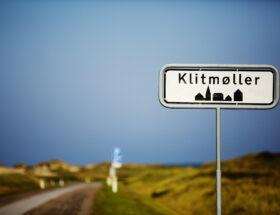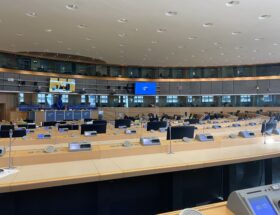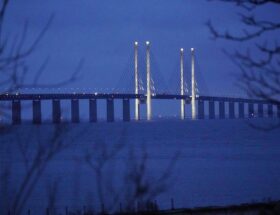Students play cards during down time after classes. While students have responsibilities at school, like attending classes and chores, they find plenty of time to spend with friends. // CREDIT: Conor Courtney
In Danish folk high schools, the curriculum includes everything from archery to yoga to practical sustainability. But what the students learn there is something quite different: self-worth and a sense of community.
Nine students reach out their middle fingers, rotating their outstretched arms around their shoulders to let them disappear briefly behind the head and come forward again via the hip. Coach Daniel Bager laughs: “That’s the only place you’re allowed to do that!” The exercise is part of Daniel’s archery training in Nordfyns Højskole in the north of Funen which takes place two days a week.
Those who come from Denmark know the principle of Folk Højskole (Folk Highschool), some even like to say it is part of their DNA. The first one opened in 1844, and since then more and more have been added, up to almost 70 today. Its idea originates from the philosopher, author, and now national hero Nikolaj Frederik Severin Grundtvig, who wanted to contribute to the democratic education of the Danish people in the early years of the 19th century.
Ordinary people, especially peasants and poorer sections of the population, learned about their history, language, and cultural heritage in schools. The focus was also on shaping the nation and finding a kind of common sense of being Danish. Democracy also played a big role in those schools.
Today, almost every Folk Highschool has its own focus, but that doesn’t really matter. In general, the schools are open to anyone from 18 to 24 who can afford the fees of around 200 euros a week. Students live, eat, and study together at the school. A semester lasts about four months. There are no tests, grades or certificates, and the students decide for themselves which classes to attend. For many, this is the epitome of freedom.
Maria, Silas and Theis, for example, have chosen sport as one of their main subjects, and now they are standing in the small sports hall, bows lined up on the floor, quivers attached to the waistbands of their trousers, with the neon-coloured feathers of their arrows sticking out of them. Three students each take one of the bows, stand sideways with their legs spread to the targets about ten metres away, clamp the arrow, backhand back, exhale once, then the arrow shoots out of the holder. The rhythm of clattering arrows, the swinging air and the impact becomes a steady background noise. Between the rounds the points are counted.



// CREDIT: Conor Courtney
Coach Daniel Bager explains that success is not what matters at all. It is important to him to show the students a way to deal with stress and nervousness. Those who can do this on the bow also have a better chance of calming themselves down in everyday life.
To become a teacher at a Folk Highschool, you don’t need formal training, instead your personal interest in the subject and the passion behind it determines your lessons. They don’t educate as teachers, but as people, each with their own story and personality.
What happens as a result can be observed quite easily: the students enjoy coming to class. “In normal classes, you just sit and listen and have a slideshow, but we go out to see and talk to other people. It is so empowering and inspiring,” Cécé explains, “that’s so cool, you can do things like this in this school.”
She and Maria are sitting in the big dining room, where they and about 60 other students plus teachers are gathering three times a day. Eating together is a fix part in everyday life at the Folk Highschool and the whole school comes together at long tables to share meals and thoughts. Anyone can announce upcoming events – such as movie nights or workshops hosted by students.
Cécé’s time in Nordfyns is a break from the French education system, which focuses mainly on success and getting ahead. Instead of starting her studies right away, she is here now and has found her freedom. She says she’s trying things she wouldn’t have dared before – like cutting her hair, tousling through her black crop. “I feel so safe here compared to any other place. You can be yourself and people are not going to judge you. That’s the magic about Højskole”.
As Maria reflects on her time at Folk Highschool, she purses her lips for a moment, squints her eyes, then says clearly:

“I was surprised how much more confident you can become when you have a good community and when you are around good people, and everyone is encouraging you and everyone is uplifting you. It can mean a lot more than you can ever imagine.”
Maria says that the community at the school has bouyed her confidence.
// CREDIT: Conor Courtney
At first glance, the curriculum may seem to be mixed together without a concept: Sports, Danish Language and Culture, Yoga, Human and Learning, Practical Sustainability, Crossfit, etc., but in Folk Highschools you don’t teach in a subject but with a subject, people often say. And what is learned is self-value and self-confidence. A basis that can give the students support in all kinds of situations. Instead of theories about it, the pupils learn very practically what that means.
Take archery, for example: it is not about scoring the most points, being the best or learning the most sophisticated technique, but about trying something new, observing one’s own progress and learning to deal with psychological pressure.
Thomas Trier, principal of Nordfyns Højskole, still observes the impact of Folk Highschools on today’s Danish society. Especially when it comes to decision making and everybody sits together to announce their opinion. “I don’t know who had the influence – society on Folk Highschools or the other way round, but it plays a big role in thinking about who we are and how we are doing things,” he says.
Although the Folk Highschools are not part of the formal education system, they are financially supported by the state. They were subsidised with 74 million euros in 2015, which is about half of their costs. Overall, Denmark is the country in the EU that spends the most money on education: 7.3 percent of GDP. The EU average is 4.6 percent. They have also had a lasting impact on the Danish way of thinking about education.
“The Folk Highschools have always focused on teaching how to be human instead of teaching that you are a result of different tests,” says Jeppe Lau Nielsen, supervisor of the Folk Højskole at the Danish Ministry of Culture. “I definitely think that the formal educational system in Denmark can learn a lot of the free school’s way of teaching”. This rethinking process has not yet come to an end, right now a reform of the formal education system is being discussed.
Perhaps the openness to somewhat alternative forms of teaching is one of the reasons why Denmark has been ranked the World’s Best Education System in 2020 and why other European countries often look enviously to the North when it comes to education. The Scandinavian country occupies an almost equally good position in lifelong learning. 15 percent of 20–29-year-olds participate in informal and formal education, such as Folk Highschool, after their mandatory schooling. That is fourth place in the EU comparison.
The students’ motives for coming to the school are as varied as they are, but they are all here voluntarily, even pay for it, and not for very little.

// CREDIT: Conor Courtney

// CREDIT: Conor Courtney
Theis, one of the students, says it’s a “gateway to try interests, rediscover my self confidence and self-esteem.” He has struggled a lot with himself, his body, and his mental health in the past. Here he feels so comfortable that it is easy for him to talk about it.
It is his second term at the Folk Highschool and he still often sits together with the boys from the first semester and shares his thoughts. He has noticed that his own openness encourages others to open as well. His wish is to pass on these experiences later – as a personal trainer with a focus on mental health and well-being and even later, if it comes up, perhaps as a teacher at a Folk Highschool. Theis has found a footing in life.
His flatmate Silas sits across from him on his bed, in between them two messy chairs that serve as nightstands and a small table with piles of stuff on it. Their walls are spiked with some posters: a landscape for Theis and one of the archery targets for Silas. Just as the other students on the floor, they don’t just share their room but their experiences. When they all want to gather, there’s the common room with a bunch of sofas, books, games and a TV. Most of the time at least one person sits in the space to be joined.
Silas delves into his past himself. Here, this is the complete opposite of what he has already experienced in his 18 young years. Silas’ past is a dark place. But the community of others has picked him up, he has learned to trust and communicate honestly. He feels safer here than ever – otherwise he would have kept the dark place to himself too.


It’s mid-December and while seven students stretch on the colourful yoga mats in the common room, it starts to snow outside. The flakes slowly fall on the other site of the big window front that faces towards a big, open field. Soon Thomas Trier’s first year as headmaster of Nordfyns will be over. Here he has found what he always tried to tell people when he worked as a theatre director: how to live a better life. Now he teaches it. The cornerstone for him is an education that makes people grow.
“For young people, it will be a part of their life forever. They are not robots. You also want to have a life; you function in your professional life also as a person. It’s a big part of humanity. You have some values to find out: Who am I? And who am I in relation to other people? At the Folk High School you become a socially skilled person, that’s worth so much.”

// CREDITS: Conor Courtney









